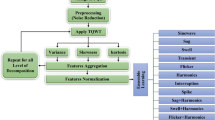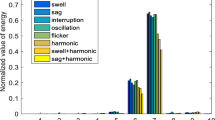Abstract
In this paper, recently developed variants of wavelet transform, namely the maximum overlapping discrete wavelet transform and the second-generation wavelet transform, are used for detection of ten types of the power quality (PQ) disturbance signals. Further, the features of PQ signal disturbances are extracted using these wavelet transforms. Those extracted features are then used to classify various PQ disturbances. Random forest (RF) classifier is presented in this paper. The RF is constructed with multiple trees for classification of large number of classes simultaneously. In order to represent realistic situation, the proposed technique is tested with noisy data.











Similar content being viewed by others
References
Abdel-Galil, T., El-Saadany, E., Youssef, A., & Salama, M. (2005). Disturbance classification using hidden markov models and vector quantization. IEEE Transactions on Power Delivery, 20(3), 2129–2135.
Angrisani, L., D’aponte, P., & Testa, A. (1998). A measurement method based on the wavelet transform for power quality analysis. IEEE Transactions on Power Delivery, 13(4), 990–998.
Biswal, B., Biswal, M., Mishra, S., & Jalaja, R. (2014). Automatic classification of power quality events using balanced neural tree. IEEE Transactions on Industrial Electronics, 61(1), 521–530.
Biswal, M., & Dash, P. K. (2013). Measurement and classification of simultaneous power signal patterns with an s-transform variant and fuzzy decision tree. IEEE Transactions on Industrial Informatics, 9(4), 1819–1827.
Breiman, L. (2001). Random forests. Machine Learning, 45(1), 5–32.
Brown, R. A., & Frayne, R. (2008). A fast discrete s-transform for biomedical signal processing, In Engineering in medicine and biology society, 2008. EMBS 2008. 30th annual international conference of the IEEE (pp. 2586–2589), IEEE.
Chilukuri, M., Dash, P., & Basu, K. (2004). Time-frequency based pattern recognition technique for detection and classification of power quality disturbances, In TENCON 2004. 2004 IEEE region 10 conference (Vol. 100, pp. 260–263), IEEE.
Cutler, D. R., Edwards, T. C, Jr, Beard, K. H., Cutler, A., Hess, K. T., Gibson, J., et al. (2007). Random forests for classification in ecology. Ecology, 88(11), 2783–2792.
Daubechies, I. (1988). Orthonormal bases of compactly supported wavelets. Communications on pure and applied mathematics, 41(7), 909–996.
Daubechies, I., & Sweldens, W. (1998). Factoring wavelet transforms into lifting steps. Journal of Fourier analysis and applications, 4(3), 247–269.
Dehghani, H., Vahidi, B., Naghizadeh, R., & Hosseinian, S. (2013). Power quality disturbance classification using a statistical and wavelet-based hidden markov model with dempster-shafer algorithm. International Journal of Electrical Power and Energy Systems, 47, 368–377.
Douglas, J. (1993). Solving problems of power quality, EPRI Journal (Electric Power Research Institute);(United States), 18(8).
Gabor, D. (1946). Theory of communication. Part 1: The analysis of information. Journal of the Institution of Electrical Engineers-Part III: Radio and Communication Engineering, 93(26), 429–441.
Gaouda, A., Salama, M., Sultan, M., & Chikhani, A. (1999). Power quality detection and classification using wavelet-multiresolution signal decomposition. IEEE Transactions on Power Delivery, 14(4), 1469–1476.
Ghosh, A. K., & Lubkeman, D. L. (1995). The classification of power system disturbance waveforms using a neural network approach. IEEE Transactions on Power Delivery, 10(1), 109–115.
Gu, Y. H., & Bollen, M. H. (2000). Time-frequency and time-scale domain analysis of voltage disturbances. IEEE Transactions on Power Delivery, 15(4), 1279–1284.
Hafez, A. G., & Ghamry, E. (2013). Geomagnetic sudden commencement automatic detection via modwt. IEEE Transactions on Geoscience and Remote Sensing, 51(3), 1547–1554.
Hasheminejad, S., Esmaeili, S., & Jazebi, S. (2012). Power quality disturbance classification using s-transform and hidden markov model. Electric Power Components and Systems, 40(10), 1160–1182.
Kohavi, R., & Quinlan, J. R. (2002). Data mining tasks and methods: Classification: Decision-tree discovery. In W. Klösgen & J. M. Zytkow (Eds.), Handbook of data mining and knowledge discovery (pp. 267–276). New York, NY: Oxford University Press, Inc.
Kumar, A., Joshi, L. K., Pal, A., & Shukla, A. (2011). MODWT based time scale decomposition analysis of BSE and NSE indexes financial time series. International Journal of Mathematical Analysis, 5(27), 1343–1352.
Lee, C.-Y., & Shen, Y.-X. (2011). Optimal feature selection for power-quality disturbances classification. IEEE Transactions on Power Delivery, 26(4), 2342–2351.
Manjunath, A., & Ravikumar, H. (2010). Comparison of discrete wavelet transform (dwt), lifting wavelet transform (lwt) stationary wavelet transform (swt) and s-transform in power quality analysis. European Journal of Scientific Research, 39, 569–576.
Masoum, M., Jamali, S., & Ghaffarzadeh, N. (2010). Detection and classification of power quality disturbances using discrete wavelet transform and wavelet networks. IET Science, Measurement and Technology, 4(4), 193–205.
Mishra, S., Bhende, C., & Panigrahi, B. (2008). Detection and classification of power quality disturbances using s-transform and probabilistic neural network. IEEE Transactions on Power Delivery, 23(1), 280–287.
Mwitondi, K. S. (2013). Data mining with Rattle and R. Journal of Applied Statistics, 40(2), 464–464.
Panigrahi, B., & Pandi, V. R. (2009). Optimal feature selection for classification of power quality disturbances using wavelet packet-based fuzzy k-nearest neighbour algorithm. IET Generation, Transmission and Distribution, 3(3), 296–306.
Percival, D. B., & Walden, A. T. (2006). Wavelet methods for time series analysis (Vol. 4). Cambridge: Cambridge University Press.
Polikar, R. (2006). The engineers ultimate guide to wavelet analysis. College of Engineering retrieved, Rowan University.
Poona, N., & Ismail, R. (2014). Using boruta-selected spectroscopic wavebands for the asymptomatic detection of fusarium circinatum stress. IEEE Journal of Selected Topics in Applied Earth Observations and Remote Sensing, 7(9), 3764–3772.
Reaz, M. B. I., Choong, F., Sulaiman, M. S., Mohd-Yasin, F., & Kamada, M. (2007). Expert system for power quality disturbance classifier. IEEE Transactions on Power Delivery, 22(3), 1979–1988.
Samantaray, S., Kamwa, I., & Joos, G. (2010). Ensemble decision trees for phasor measurement unit-based wide-area security assessment in the operations time frame. Generation, Transmission and Distribution, IET, 4(12), 1334–1348.
Santoso, S., Powers, E. J., & Grady, W. (1997). Power quality disturbance data compression using wavelet transform methods. IEEE Transactions on Power Delivery, 12(3), 1250–1257.
Upadhyaya, S., & Mohanty, S. (2013). Power quality disturbance detection using wavelet based signal processing. In India conference (INDICON), 2013 annual IEEE (pp. 1–6), IEEE.
Yilmaz, A. S., Subasi, A., Bayrak, M., Karsli, V. M., & Ercelebi, E. (2007). Application of lifting based wavelet transforms to characterize power quality events. Energy conversion and management, 48(1), 112–123.
Zafar, T., & Morsi, W. (2013). Power quality and the un-decimated wavelet transform: An analytic approach for time-varying disturbances. Electric Power Systems Research, 96, 201–210.
Zhang, H., Liu, P., & Malik, O. (2003). Detection and classification of power quality disturbances in noisy conditions, In Generation, transmission and distribution, IEE proceedings- (Vol. 150, pp. 567–572), IET.
Zhao, F., & Yang, R. (2007). Power-quality disturbance recognition using s-transform. IEEE Transactions on Power Delivery, 22(2), 944–950.
Zhu, T., Tso, S., & Lo, K. (2004). Wavelet-based fuzzy reasoning approach to power-quality disturbance recognition. IEEE Transactions on Power Delivery, 19(4), 1928–1935.
Author information
Authors and Affiliations
Corresponding author
Rights and permissions
About this article
Cite this article
Upadhyaya, S., Mohanty, S. & Bhende, C.N. Hybrid Methods for Fast Detection and Characterization of Power Quality Disturbances. J Control Autom Electr Syst 26, 556–566 (2015). https://doi.org/10.1007/s40313-015-0204-4
Received:
Revised:
Accepted:
Published:
Issue Date:
DOI: https://doi.org/10.1007/s40313-015-0204-4




